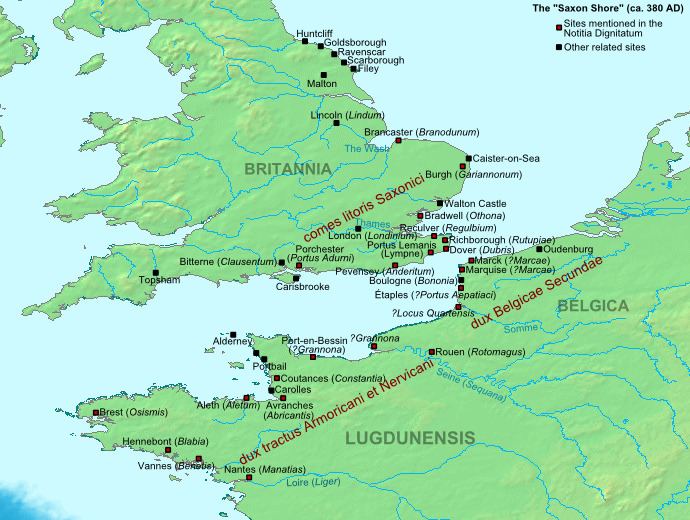 | ||
Active end of the fourth century to the fifth century Type commander of a stretch of the Rhine limes and Litus Saxonicum (Saxon Shore) | ||
The Dux Belgicae secundae (literally "commander of the second Belgic province") was a senior officer in the late Roman army of the West, Supreme Commander of the limitanei and a naval squadron to the so-called Saxon Shore in Gaul.
Contents
A known Dux was the Frankish king Childeric I (late 5th century).
Definition
The Office was probably established around 395 AD. At the imperial court the Dux counted to the highest ranking class of viri spectabiles. In the Notitia Dignitatum be for the Gallic part of the Litus saxonicum two high command units and units for securing the coasts of Flanders (Belgica II), of Normandy (province Lugdunensis II) and of Brittany (province Lugdunensis III) enumerated in the above Commander and the adjacent tract Dux Armoricani et Nervicani. These two section commanders were probably the successors of a public official, who formerly held the command over both the British and on the Gallic part of the Saxon Shore (Comes maritimi). Their coastal defense was maintained up to the mid-5th Century.
In the final phase of Roman rule over Gaul acted the commander of the Salian Franks, Childeric, as a civilian administrator and commander of the warrior groups on the territory around the town of Tournai in the north of the province. The city served as his residence and administrative headquarter. His power was based, inter alia, to also resident here armament workshops. It is unclear whether Childerich (rex) even as Roman general or already own as king acted; most likely were both offices then merged with each other already. Childerich but felt probably especially true of late Roman committed military aristocracy of Gaul. This combination of civilian and military powers can a prominent position in the Reich Administration Childerich guess. Perhaps he has been confirmed by a high Roman dignitary in his office. It is believed that he as Dux before the other barbarisn commander ranked. In his - 1653 discovered - grave mound was found among other things. Byzantine gold coins, a brocade coat (paludamentum) and a golden clasp to close the coat. The former have been interpreted in the research as wages for work done military service, the latter as rank insignia of late Roman army.
Forts, officers and units
In addition to administrative staff (officium) were still eight tribunes / prefects and their units available to this Dux (sub dispositione):
Tribunus militum Nerviorum, a prefect for Sarmatian settlers: Praefectus Sarmatarum gentilium, inter Renos et Tambianos secundae provinciae Belgicae, and four prefects, that commanded the contingents of Germanic Laeti:
Their shield emblems are not shown in the Notitia, however.
The Dux had in earlier times, however, more units, that have united under his command. Arnold Hugh Martin Jones identified the origin of, inter alia, units from the Gallic army. They originally came also from the Belgica II and their names are the same as the well-known cities of this province:
Unlike vexillations of other Duces, these units are no longer indicated standing additionally under the command of the Dux Belgicae II. It seems that this province after the destruction of the border units on the Rhine (Rhine crossing of 406 AD) had to relinquish, one of the first many of their units to the field army.
